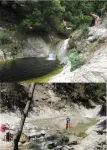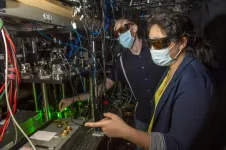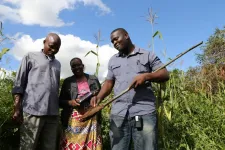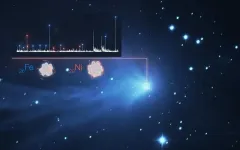What causes pools below waterfalls to periodically fill with sediment?
New study published in Geology
2021-05-19
(Press-News.org) Boulder, Colo., USA: Deep pools below waterfalls are popular recreational swimming spots, but sometimes they can be partially or completely filled with sediment. New research showed how and why pools at the base of waterfalls, known as plunge pools, go through natural cycles of sediment fill and evacuation. Beyond impacting your favorite swimming hole, plunge pools also serve important ecologic and geologic functions. Deep pools are refuges for fish and other aquatic animals in summer months when water temperatures in shallow rivers can reach lethal levels. Waterfalls also can liquefy sediment within the pool, potentially triggering debris flows that can damage property and threaten lives. Over geologic time, pools are importance because the energetic waterfall jet can erode the rock walls of the pool--slowly moving the waterfall upstream, while simultaneously creating a deep canyon in its wake.
Reporting in the journal Geology today, Joel Scheingross of the University of Nevada Reno, and Michael Lamb of the California Institute of Technology, provided a new theoretical framework to predict when plunge pools fill with sediment, and when they subsequently evacuate that sediment exposing the rock walls of the pool to erosion. They showed that waterfall plunge pools tend to fill with sediment during modest river floods when sediment is transported in the reach upstream of the waterfall, but the waterfall jet is too weak to move all the sediment it receives from upstream. In contrast, during large floods, a strong waterfall jet can more efficiently move sediment up and out of the pool, outpacing the delivery of sediment from upstream, and exposing bedrock to erosion.
Scheingross and Lamb showed that waterfall plunge pools are most likely to fill with sediment following landscape disturbances--such as wildfire or landslides--that cause large influxes of sediment to rivers, or during prolonged droughts when river floods are rare. This information is useful to scientists and land managers interested in maintaining habitat and mitigating natural hazards. They also showed that bedrock erosion in plunge pools likely occurs only during large, infrequent floods, which tend to happen every 10 years or even less frequently. Therefore, the slow march of waterfalls upstream over geologic time likely occurs by fits and starts at a cadence set by extreme flood events.
INFORMATION:
Mass balance controls on sediment scour and bedrock erosion in waterfall plunge pools
Joel Scheingross and Michael Lamb
Contact: jscheingross@unr.edu, University of Nevada Reno, Department of Geological Sciences and Engineering, Reno, Nevada
URL: https://pubs.geoscienceworld.org/gsa/geology/article/doi/10.1130/G48881.1/598762/Mass-balance-controls-on-sediment-scour-and
GEOLOGY articles are online at http://geology.geoscienceworld.org/content/early/recent. Representatives of the media may obtain complimentary articles by contacting Kea Giles at the e-mail address above. Please discuss articles of interest with the authors before publishing stories on their work, and please make reference to GEOLOGY in articles published. Non-media requests for articles may be directed to GSA Sales and Service, gsaservice@geosociety.org.
https://www.geosociety.org
[Attachments] See images for this press release:

ELSE PRESS RELEASES FROM THIS DATE:
2021-05-19
Florida State University researchers have more insight into a strange sea creature found in oceans around the world and what their presence means for the health of a marine ecosystem.
Scientists have thought that salps -- small marine organisms that look like clear, gelatinous blobs -- competed for resources with krill, shrimp-like creatures that are an important food source for many marine animals. But new research published in Limnology and Oceanography suggests that salps are actually competing for food with an organism known as a protist.
An image of a salp taken during research. New research published in Limnology and Oceanography suggests that salps are actually competing for food with an organism known as a protist. (Courtesy of ...
2021-05-19
A heart surgeon doesn't need to grasp quantum mechanics to perform successful operations. Even chemists don't always need to know these fundamental principles to study chemical reactions. But for Kang-Kuen Ni, the Morris Kahn associate professor of chemistry and chemical biology and of physics, quantum spelunking is, like space exploration, a quest to discover a vast and mysterious new realm.
Today, much of quantum mechanics is explained by Schrödinger's equation, a kind of master theory that governs the properties of everything on Earth. "Even though ...
2021-05-19
The amount of nutrients people get from the crops that they eat is a type of 'postcode lottery', according to new research that has analysed thousands of cereal grains and soils as part of a project to tackle hidden hunger in Malawi and Ethiopia.
A global team led by the University of Nottingham and its Future Food Beacon including academics and researchers from Addis Ababa University (AAU) in Ethiopia and Lilongwe University of Agriculture and Natural Resources (LUANAR) in Malawi, working on the GeoNutrition project, have discovered more about the relation between soils, crops and micronutrient deficiencies among people living there. Their ...
2021-05-19
HERSHEY, Pa. -- Parkinson's disease is the second most common neurodegenerative disease and affects more than 10 million people around the world. To better understand the origins of the disease, researchers from Penn State College of Medicine and The Hebrew University of Jerusalem have developed an integrative approach, combining experimental and computational methods, to understand how individual proteins may form harmful aggregates, or groupings, that are known to contribute to the development of the disease. They said their findings could guide the development of new therapeutics to delay or even halt the progression of neurodegenerative diseases.
Alpha-synuclein ...
2021-05-19
A new study by a Belgian team using data from the European Southern Observatory's Very Large Telescope (ESO's VLT) has shown that iron and nickel exist in the atmospheres of comets throughout our Solar System, even those far from the Sun. A separate study by a Polish team, who also used ESO data, reported that nickel vapour is also present in the icy interstellar comet 2I/Borisov. This is the first time heavy metals, usually associated with hot environments, have been found in the cold atmospheres of distant comets.
"It was a big surprise to detect iron and nickel atoms in the atmosphere of all the comets ...
2021-05-19
Where you live may predict your long-term survival after experiencing a first heart attack. Socioeconomic factors -- such as income, education, employment, community safety and more -- have long been associated with cardiovascular health, but less is known about how neighborhood factors impact outcomes after myocardial infarction (MI), particularly among younger individuals. In an article published in JAMA Cardiology, researchers from Brigham and Women's Hospital and colleagues studied the health records of 2,002 patients who experienced an MI at or before age 50. They found that even after adjusting ...
2021-05-19
What The Study Did: Researchers evaluated racial and ethnic diversity among obstetrics and gynecology, surgical and nonsurgical residents in the United States from 2014 to 2019.
Authors: Claudia L. Lopez, M.D., of the University of California, Davis, is the corresponding author.
To access the embargoed study: Visit our For The Media website at this link https://media.jamanetwork.com/
(doi:10.1001/jamanetworkopen.2021.9219)
Editor's Note: The article includes funding/support disclosures. Please see the article for additional information, including other authors, author contributions and affiliations, conflict of interest and financial disclosures, and funding and support.
# ...
2021-05-19
What The Study Did: Registry data were used to examine the association between living in a socioeconomically disadvantaged area and long-term survival among patients who had their first heart attack at or before age 50.
Authors: Ron Blankstein, M.D., of Brigham and Women's Hospital in Boston, is the corresponding author.
To access the embargoed study: Visit our For The Media website at this link https://media.jamanetwork.com/
(doi:10.1001/jamacardio.2021.0487)
Editor's Note: The article includes conflict of interest disclosures. Please see the articles for additional information, including other authors, author contributions and affiliations, conflicts of interest and financial ...
2021-05-19
What The Study Did: This study looked at the use of consumer digital information for COVID-19 control U.S. adults consider to be acceptable and the factors associated with higher or lower approval of using this information.
Authors: David Grande, M.D., M.P.A., of the University of Pennsylvania, is the corresponding author.
To access the embargoed study: Visit our For The Media website at this link https://media.jamanetwork.com/
(doi:10.1001/jamanetworkopen.2021.10918)
Editor's Note: The article includes conflict of interest and funding/support disclosures. Please see the article for additional information, including other authors, author contributions and affiliations, conflict of interest and financial disclosures, and funding and support.
# # #
Media advisory: ...
2021-05-19
What The Study Did: SARS-CoV-2 seropositivity wasn't associated with low levels of vitamin D independently of other risk factors.
Authors: Yonghong Li, Ph.D., of Quest Diagnostics in San Juan Capistrano, California, is the corresponding author.
To access the embargoed study: Visit our For The Media website at this link https://media.jamanetwork.com/
(doi:10.1001/jamanetworkopen.2021.11634)
Editor's Note: The article includes funding/support disclosures. Please see the article for additional information, including other authors, author contributions and affiliations, ...
LAST 30 PRESS RELEASES:
[Press-News.org] What causes pools below waterfalls to periodically fill with sediment?
New study published in Geology



